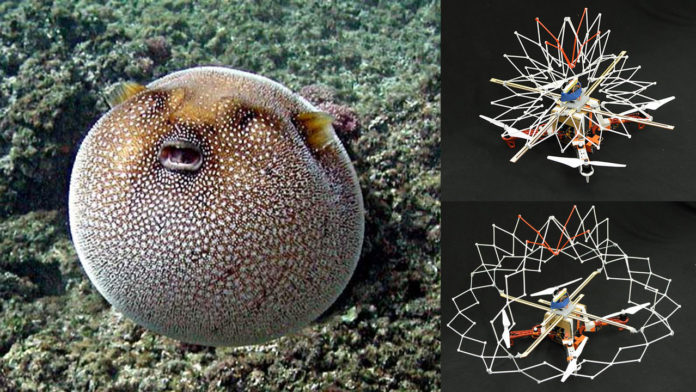The pufferfish, also called blowfish, swellfish, globefish, balloonfish, and bubble fish, got the name because of their ability to inflate themselves to their normal size several times by swallowing water or air when threatened.
Getting inspired by pufferfish, engineers at the University of Colorado Boulder has designed a robot called PufferBot, that can do the same thing. The aim was to improve drone safety.
PufferBot is a skittish machine that comes complete with a plastic shield that expands in size at a moment’s notice—forming a robotic airbag that could prevent dangerous collisions between people and machines.
Graduate student Hooman Hedayati said, “We were trying to design a safer robot that could communicate safety information to the user. We started by looking at how animals do the same thing.”
“I’ve been working with drones for years, but whenever I go out and fly robots, I still feel not confident. What happens if it falls on someone and hurts them? Technologies like PufferBot can help.”
Hedayati said, “There are many videos on YouTube- showing drone fails from spectacular crashes to collisions with humans, abound. Those kinds of dangers could make many people (justifiably) wary about inviting robots into their homes.”
“We’ve been told that robots are great and can do a lot of tasks. But where are these robots? Why are they not in our houses? Why do you see them inside cages in factories?”
In practice, PufferBot looks less like a fish and more like a Hoberman sphere. Its airbag is made from hoops of plastic that are fastened to its top and can inflate from roughly 20 inches to 33 inches in diameter.
Under ordinary conditions, the shield collapses and stays out of the way. However, when danger is close, that is when PufferBot puffs up, broadening those hoops over its four, turning rotors to get them far from individuals and obstacles.
Hedayati said, “It can act as a temporary cage. It also communicates with users to tell them: ‘Don’t come close to me.'”
Engineers hope that one day, this hovering quadcopter drone could fly into a collapsed building to search for survivors, all while using its shield to avoid smashing into rubble.
Engineers will present their results virtually on Oct. 25 at the International Conference on Intelligent Robots and Systems (IROS 2020).
